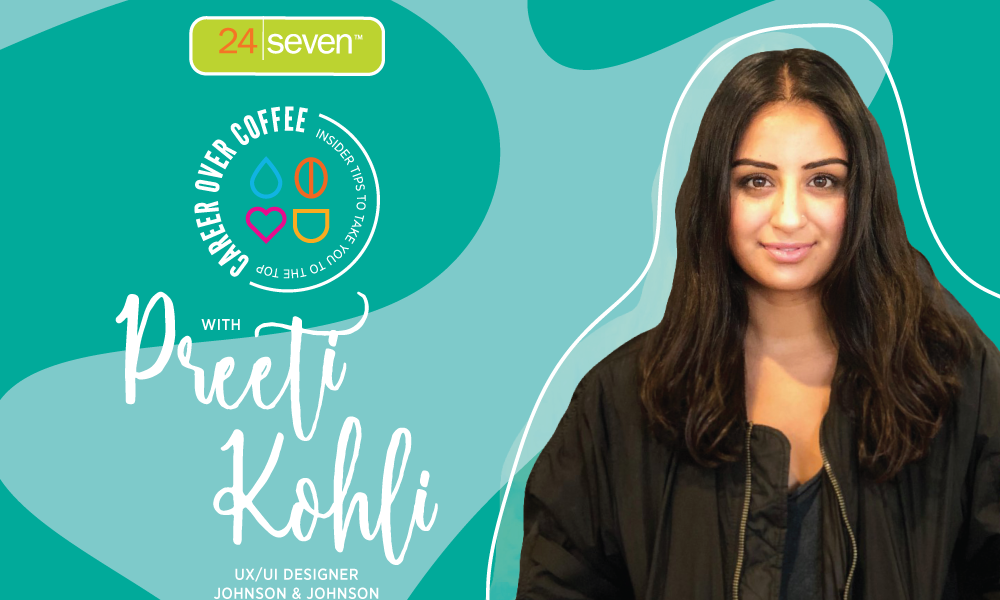In today’s Career Over Coffee, we spoke virtually with UX/UI Designer, Preeti Kohli at Johnson & Johnson, to discuss the role that UX/UI design plays in our daily lives, the must have skills for success, and how to navigate making a pivot in your career when the time feels right.
To begin, can you break down the difference between UX and UI Design?
User Experience (UX) can be the system organization of just about anything. Simply put, a UX Designer would look at an experience and ask themselves, “how can you improve the physical experience a user has with a specific device, website, kiosk, etc”? User Interface (UI) on the other hand, relates to the design of the interface, typically within the digital space and refers more to the semantics of the design itself, rather than the physical aspects the user may encounter.
What do you feel are the most in demand UX/UI skills for candidates to have?
For anyone in the UX/UI field, it’s important to have a strong understanding of graphic design concepts and fundamentals, as well as some basic knowledge of typography. When you are working with assets and content, it’s essential for Designers to have a deeper understanding of the connection between the two, because ultimately the interaction between these elements is going to affect the final outcome. With this, being research-minded is something that will take you really far, not just within UX/UI, but within the Digital Marketing and Development spaces, as they are constantly changing and evolving.
What’s the best way to stay on top of emerging skills?
Staying on top of your skills as a UX/UI Designer is hugely important – I can’t emphasize that enough! Because the tools we use are always evolving and updating, I like to do daily UI challenges. These give you a chance to work with new features in the space, while keeping you up to date across various platforms. Another example of this is Google IO, as new features are constantly being released, it gives you the ability to keep a pulse on what’s really essential and how you can apply that in your day to day.
What teams do you partner with the most in your role at Johnson & Johnson?
The UX/UI teams works cross functionally with the Development and Design teams. I feel that being able to pivot and work with other teams is a huge part of our overall success as it allows us to work out kinks along the way. In terms of external partnerships, we work very closely with both Surgeons and Medical Sales Representatives, which I find to be a unique perk to our job. Because the products we create are being used directly in the field, having open communication with and perspective from the individuals who use the physical end product is huge. We need to know that what works for us, will also work just as well for them.
You pivoted in your career; can you tell us more about that?
Prior to my role with Johnson & Johnson I worked in Marketing and Graphic Design. I enjoyed both fields, but I didn’t feel passionate about either. So I took the opportunity to apply my interest in strategic thinking and creativity which blended perfectly into UX/UI.
What is your favorite aspect of being a UX/UI Designer?
One of my favorite parts of the job is being able to enhance existing product to better the user experience as a whole. As a UX/UI Designer you won’t ever face the issues the user has to face, so learning about niche problems as you build a product is key. We think about things from the perspective of building a home – how many doors are there in the home, how many doors do you have to go through to get outside, and how many windows get sunlight? These perspectives seem unrelated, but it ultimately gives you the bigger picture towards the feasibility of a product.
When building your portfolio, what is something to keep in mind?
Building a portfolio can be extremely frustrating, and it’s a process that many don’t think about enough. You need to present your work in a way that’s digestible to the viewer, regardless of the field they work in. I could show you a completed wireframe and you may not grasp the full understanding, whereas if I show you the wireframe being developed stage by stage, you would be able to put the pieces together in a more concise way, like a puzzle in a way.
What’s one piece of advice you’d give to someone trying to break into the UX/UI space?
For anyone thinking about pivoting into the space, I’d highly recommend reading Donald Norman’s book, The Design of Everyday Things. This book was my first exposure to UX/UI and it breaks down the fact that no matter how technical or physical a problem is, there is always going to be a user issue that needs to be solved. Secondly, learn XD or Sketch. XD is preferred within the field, but once you know one of the tools, you’ll quickly get the hang of the other. For more trends and resources, click here!
